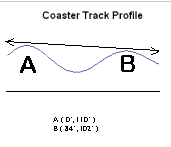
ALGEBRA AT GREAT AMERICA
COASTER: Friction Slope
Once a roller coaster is pulled to the top of its first hill and released, the coaster's potential energy (energy due to height) is determined by that hill's height. When the coaster descends, its potential energy decreases but its kinetic energy (energy of motion) increases since the coaster speeds up as it falls. Throughout the ride that follows, the combination of potential and kinetic energy would, in an ideal world, be constant. Like any mechanical device, however, some of a roller coaster's energy is transferred to other objects in its environment during operation. This energy "loss" to the coaster means that each subsequent hill's maximum allowable height must be somewhat lower that the one before it so the coaster's remaining energy will carry it successfully over the rise. The line that marks the maximum allowable hill height along the length of the track is called the ride's friction slope. In the diagram below, a "straightened" track profile, shows (x,y) = (distance, height) coordinates to identify the relative positions and heights of the first two of a ride's hills. Use the values in the diagram to complete the tasks that follow.

- What is the numerical value of the slope of this line? Explain the significance of the numbers in the slope ratio to the "forward" motion of the coaster.
- Write an equation to represent the friction slope line.
- If a hilltop were located at the 850' marker, what would be its maximum allowable height?
- What would be the maximum theoretical profile length of track for this coaster? Why?
Click here for Word version
Click here for pdf version
Updated 1/28/2012